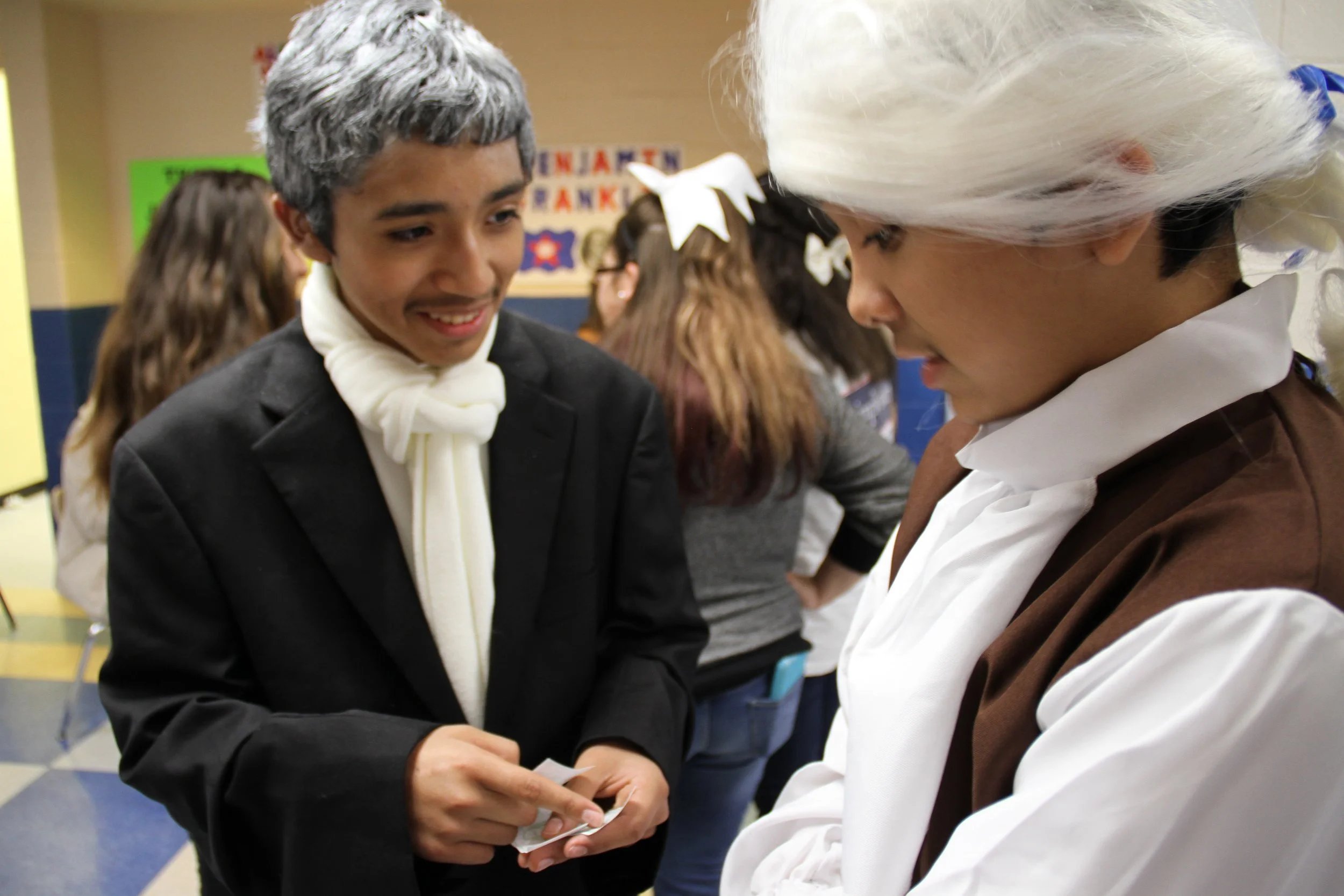Slow down, baby, and notice creative teachers
By Christie Norris and Eric Johnson
April 20, 2016 | Fayetteville Observer
Eighth-graders posing as Founding Fathers as part of West Hoke Middle School's Living Museum.
Cynthia Williams has been teaching for 23 years, and you can hear it in her voice. "Slow down, baby!" she calls after a student sprinting down a crowded hallway. "Good job, baby," she tells another, appraising a homemade costume. She is in constant motion, reassuring, directing, calming and motivating.
It's Living Museum Night at West Hoke Middle School in Raeford, and Williams is the showrunner for nearly 200 eighth-graders dressed up as American notables from the colonial era to present day.
Every few feet, a costumed student waits, ready to spring to life when parents, siblings, grandparents and neighbors wander past. It's a weeknight, long past the end of the school day, but people are crowded into every hallway, spilling over into the library and the gym.
Eighth-grade Andrew Jackson sits with his arms tensed over a briefcase, looking mean. Eighth-grade Dolley Madison is poised in front of a mirror, looking genial. And the eighth-grade Harpe Brothers (noted river pirates and highwaymen) are slumped in chairs, looking appropriately homicidal.
Students picked these historical figures themselves, delving into biographies to prepare a monologue that mixes accurate history and inventive personality. Along the way, they learn research techniques, writing skills and - most challenging of all - public speaking.
"Why are you interrupting me!" shouts adolescent Andrew Jackson, looking up from his briefcase. "Have you been to London?" inquires eighth-grade John Christopher Mahler. Down the hall, a gaggle of boys in frock coats recites lines from the musical "Hamilton," reveling in a vernacular that makes the Founding Fathers feel new and urgent.
Idea's beginning
Williams first heard about "The Living Museum" at a seminar hosted by the North Carolina Civic Education Consortium. Supported by UNC-Chapel Hill, the consortium sponsors a few hundred teachers each year to attend free workshops where they discover new teaching techniques, explore new topics with university professors, and learn from one another's experiences across the state. It's the kind of deep-thinking, energizing professional development that has become all too rare in this era of reduced budgets and tighter teaching schedules.
”The Living Museum" is a longtime favorite within the consortium's portfolio of lesson plans and activities. It's a simple way to get students out of their seats and actively engaged with history.
These classroom flourishes may seem small amid grand debates over Common Core, teacher pay, vouchers and all the other policy questions that ruffle K-12 education. A "living museum" is not going to eliminate achievement gaps, secure equitable funding, or otherwise reform public education.
But creativity in the classroom matters to students. It matters to teachers. And last month, at West Hoke Middle, it was easy to see just how much it can matter to a whole community. Williams has transformed a classroom activity into an annual celebration, uniting a diverse community around the creativity and enthusiasm of its students.
One of the strengths of "The Living Museum" - and of good teaching in general - is that it gives students a lens to see historical figures as real people, not just sepia-toned set pieces from a foreign age.
A student named Nakia Stone sat at her desk, looking pensive, waiting to recite the biography of 18th-century African-American poet Phillis Wheatley. Nakia hadn't selected Wheatley at random - she picked her because the young poetess seemed kindred.
"She likes to write about how she feels," the young girl said. "It's, like, her way to vent sometimes. Like I do, too."
Nakia might have read Wheatley's On Imagination, which offers a fine summary of the scene at West Hoke Middle. "There in one view we grasp the mighty whole / Or with new worlds amaze th' unbounded soul."
That's what our teachers can do, when we give them the time and the space to be creative - introduce new worlds and amaze the unbounded soul. It's what we want for our children, what we hope a 14-year-old might find in centuries-old poetry. Helping our increasingly diverse schoolchildren identify with American history, to see it as their own, is a vital task in a growing democracy. And it's a remarkable thing to witness.
The students lingered as the night wrapped up, enjoying the spectacle of their costumed classmates and the unexpected thrill of being at school late into the evening. Williams looked on, tired but happy.
"It gets bigger and better every year," she said. "And I know it's something they'll remember."
We should all remember that our civic health depends on good teachers and creative teaching.
Christie Norris is the director of K-12 outreach for the North Carolina Civic Education Consortium. Eric Johnson serves on the External Advisory Board for the UNC Program in the Humanities and Human Values.
Visit fayobserver.com/opinion/local_columns/christie-norris-and-eric-johnson-slow-down-baby-and-notice/article_2ede8ee1-d35b-58de-a16a-ab35fe6e4cf1.html
